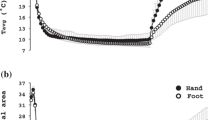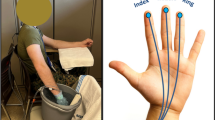Abstract
The present study aimed at investigating the spatial variability of skin temperature (T sk) measured at various points on the hand during convective and cold contact exposure. A group of 8 subjects participated in a study of convective cooling of the hand (60 min) and 20 subjects to contact cooling of the finger pad (5 min). Experiments were carried out in a small climatic chamber into which the hand was inserted. For convective cold exposure,T sk was measured at seven points on the palmar surface of the fingers of the left hand, one on the palmar surface and one on the dorsal surface of the hand. The air temperature inside the mini-chamber was 0, 4, 10 and 16°C. With the contact cold exposure, the subjects touched at constant pressures an aluminium cube cooled to temperatures of −7, 0 and 7°C in the same mini-chamber. ContactT sk was measured on the finger pad of the index finger of the left hand. TheT sk of the proximal phalanx of the index finger (on both palm and back sides), and of the middle phalanx of the little finger was also measured. The variation ofT sk between the proximal and the distal phalanx of the index finger was between 1.5 to 10°C during the convective cold exposure to an air temperature of 0°C. Considerable gradients persisted between the hand and fingers (from 2 to 17°C at 0°C air temperature) and between the phalanges of the finger (from 0.5 to 11.4°C at 0°C air temperature). The onset of cold induced vasodilatation (CIVD) on different fingers varied from about 5 to 15 min and it did not always appear in every finger. For contact cold exposure, whenT sk on the contact skin cooled down to nearly 0°C, the temperature at the area close to the contact skin could still be 30°C. Some cases of CIVD were observed in the contact skin area, but not on other measuring points of the same finger. These results indicated that local thermal stimuli were the main determinents of CIVD. Representative hand skin temperature may require five or more measuring points. Our results strongly emphasised a need to consider the large spatial and individual variations in the prediction and modelling of extremity cooling.
Similar content being viewed by others
References
Aschoff J (1944) Uber der kältedilation der extremität des menschen in eiswasser. Pflügers Arch 248:183–196
Chen F, Nilsson H, Holmér I (1994) Finger cooling by contacting cold aluminium surfaces-effect of pressure, mass and whole body thermal balance. Eur J Appl Physiol 69:55–60
Clark RE, Cohen A (1960) Manual performance as a function of rate of change in hand skin temperature. J Appl Physiol 15:496–498
Daanen HAM, Loten WA (1992) Synchronization of cold induced vasodilation in the fingers. Proceedings of The Fifth International Conference on Environmental Ergonomics, Maastricht, the Netherland, pp. 106–107
Enander A (1982) Perception of hand cooling during local air exposure at three different temperatures. Ergonomics. 25:351–361
Fox RH, Wyatt HT (1962) Cold-induced vasodilatation in various areas of the body surface of man. J Physiol 162:289–297
Gaydos HF (1958) Effect on complex manual performance of cooling the body while maintaining the hands at normal temperatures. J Appl Physiol 12:373–376
Gaydos HF, Dusek ER (1958) Effects of localized hand cooling versus total body cooling on manual performance. J Appl Physiol 12:377–380
Lewis T (1930) Observations upon the reactions of the vessels of the human skin to cold. Heart 15:177–208
Lockhart JM, Kiess HO (1975) Effect of rate and level of lowerd finger surface temperature on manual performance. J Appl Physiol 60:106–113
Lotens WA (1992) Simulation of hand cooling due to touching cold materials. Eur J Appl Physiol 65:59–65
Raman ER, Vanhuyse VJ (1975) Temperature dependence of the circulation pattern in the upper extremities. J Physiol 249:197–210
Shephard JT, Rusch NJ, Vanhoutte PM (1983) Effect of cold on the blood vessel wall. Gen Pharmacol 14:61–64
Spealman CR (1945) Effect of ambient air temperature and of hand temperature on blood flow in hands. Am J Physiol 145:218–222
Spurr GB, Hutt BK, Horvath SM (1955) The effects of age on finger temperature responses to local cooling. Am Heart J 50:551–555
Steegmann AT (1977) Finger temperatures during work in natural cold: the Northern Ojibwa. Hum Biol 49:349–362
Wilson O (1973) Experimental freezing of the finger: a review of studies. In: Edholm OG, Gunderson EKE (eds) Polar human biology. Heinemann, London
Wilson O, Goldman RF (1970) Role of air temperature and wind in the time necessary for a finger to freeze. J Appl Physiol 29:658–664
Author information
Authors and Affiliations
Rights and permissions
About this article
Cite this article
Chen, F., Liu, Z.Y. & Holmér, I. Hand and finger skin temperatures in convective and contact cold exposure. Europ. J. Appl. Physiol. 72, 372–379 (1996). https://doi.org/10.1007/BF00599699
Accepted:
Issue Date:
DOI: https://doi.org/10.1007/BF00599699




